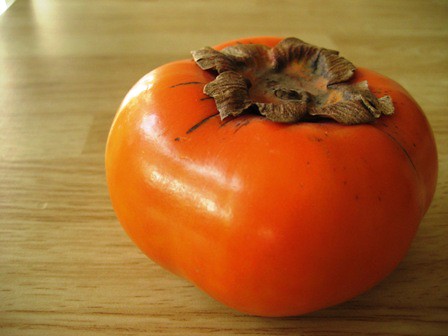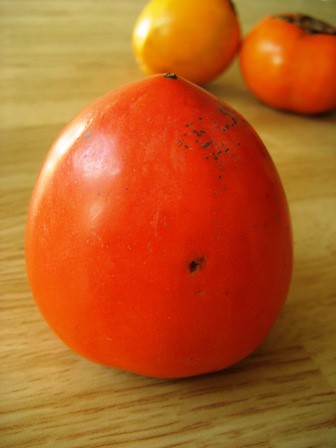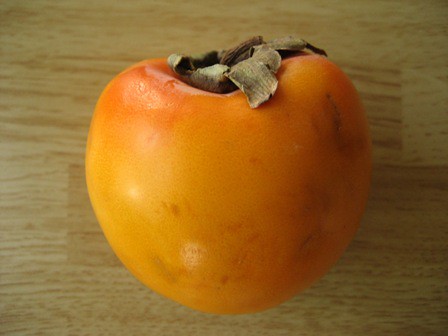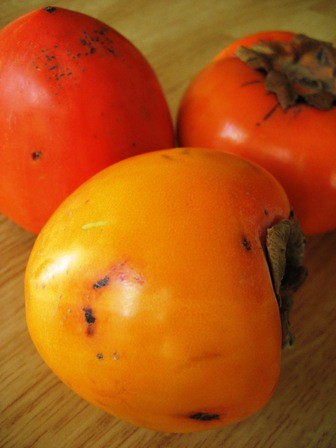 Hachiya: Radiant orange hues and a hardy heart shape define the hachiya. When firm they're incredibly astringent and practically inedible. It's only when they're so ripe and squishy that they feel that they may come apart in your hand are they edible. Indeed it should be totally gelatinous. Sweet and floral, they're perfume flavor is perfect for baking or simply eating with a spoon.
Hachiya: Radiant orange hues and a hardy heart shape define the hachiya. When firm they're incredibly astringent and practically inedible. It's only when they're so ripe and squishy that they feel that they may come apart in your hand are they edible. Indeed it should be totally gelatinous. Sweet and floral, they're perfume flavor is perfect for baking or simply eating with a spoon. Hybrid / Pollination Variants (More often than not these won't be at the store, but at a farmer's market or roadside stand)
Hybrid / Pollination Variants (More often than not these won't be at the store, but at a farmer's market or roadside stand)Amagaki: A hybrid between Hachiya and Fuji - a persimmon love child of sorts. It's actually a variety developed locally here in Sacramento by Twin Peaks farm. They are, in my opinion, the best persimmon variety. Not too gushy, not too hard, but with the bite-feel of a soft ripe pear. Just sweet enough as well that I can easily finish it, unlike the fuji or hachiya which I usually share due to their overpowering sweetness.
 Maru (aka: cinnamon persimmon): Supposedly spicy sweet and somewhat spicy and possess and dark burnt orange color and a cinnamon colored flesh. I haven't tired one of these hybrids before, so I can't say much. I understand they store incredibly well and are very juciy. Another one perfect for eating straight.
Maru (aka: cinnamon persimmon): Supposedly spicy sweet and somewhat spicy and possess and dark burnt orange color and a cinnamon colored flesh. I haven't tired one of these hybrids before, so I can't say much. I understand they store incredibly well and are very juciy. Another one perfect for eating straight.Tsurunoko (aka: chocolate persimmon): Called the chocolate persimmon not for its flavor but its dark brown color. Indeed the inside is a dark tan color, and often mottled with color imperfections making it look rotten when bit or cut into. However the flavor is sweet and much more mild than other persimmon varieties. Tried one at work and I enjoyed it though I had to get over the appearance as it looked rotted (no picture, sorries).
Hyakume (aka: brown sugar Persimmon): Very sweet and somewhat astringent it's a case of extremes making them almost inedible to most people when ripe. However, when dried out they becomes incredibly sweet with a slight molasses-y taste of brown sugar. Again, no picture as I didn't have my camera at work.
These are the ones you can usually find here in the U.S. and by that I mean most likely California. However, in Japan you can find endless varieties such as Okame and Nightengale.
For another great resource check out this persimmon profile from Figs With Bri, or for persimmon recipes check out the Food Blog Search page.










The crunchier the better as far a I am concerned with persimmons.
ReplyDeleteMy ex's grandma used to make yummy persimmon cookies and every once in a while I think about trying to make them myself. Would you use one of these types over another?
ReplyDeletejust a corection.. It's Fuyu (winter) not Fuji. You can also let them get soft and use the pulp for cookies etc. like the Hachiay.
ReplyDeleteEileen and Sue: Whoops! Typo!
ReplyDeleteIris: Hachiya. Elise over at Simply Recipes has a great recipe.
We just gleaned our Fuyu persimmon tree. They are delicious but I also find them a bit too sweet for frequent eating, and have tried numerous ways to cook, bake, and even pickle them.
ReplyDeleteIf you need any, shoot me an email!
love,
Andrea
Thank you, this is great! I love persimmons, especially the hybrid that I can get at the markets around this time.
ReplyDeleteHow very interesting! I've only ever seen the fuyu and hachiya varieties at the markets here in SF, but it stands to reason you'd have access to more in the valley. I'll have to keep my eyes better peeled to the other varieties. Love me some persimmons!
ReplyDeleteI'm in the Ozarks and we have wild persimmons here. They are much smaller being about an inch and a half in diameter. They cannot be eaten until we have "killing frost" as my mother used to say. I have never tried to make anything with them. They seem to disappear. I think deer, squirrls and other wild life make a feast of them.
ReplyDeleteTrue about the winterfrost that is needed to get the sugars out. I remember my grandfather had a tree in his garden in Switzerland, and it was always a pleasure to see the orange fruit in the winter on the black branches in a snowy surrounding. These persimmons, or kaki's as we use to call them, were only edible after te frost. The modern cultivars don't need that.
ReplyDeleteAgain I am with Mary: You forgot the American persimmon, which is all over the East Coast. Basically you wait for frost and then shake a tree: Whatever falls down you make unto baked goods like the Hachiya...
ReplyDelete